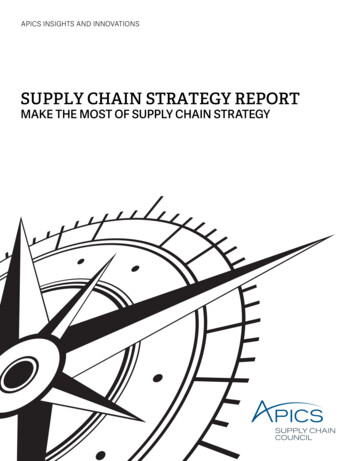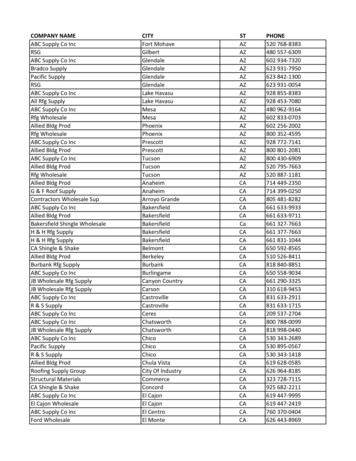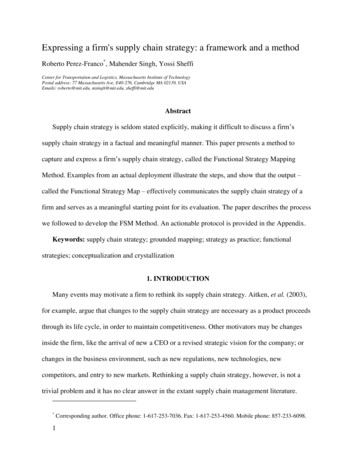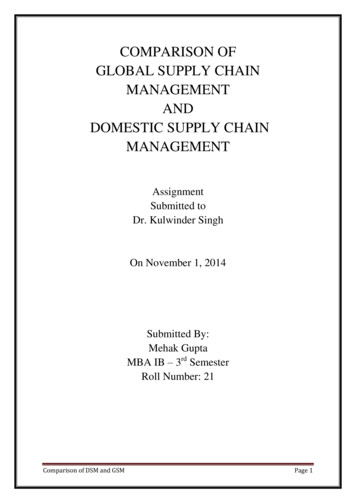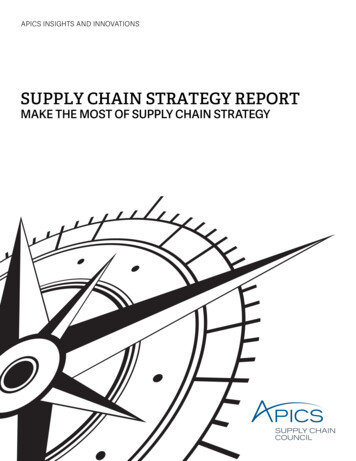
Transcription
APICS INSIGHTS AND INNOVATIONSSUPPLY CHAIN STRATEGY REPORTMAKE THE MOST OF SUPPLY CHAIN STRATEGY
APICS INSIGHTS AND INNOVATIONSABOUT THIS REPORTThis APICS report is your guide to understanding, developingand advancing supply chain strategy. It includes groundbreakingresearch, a case study and practical how-to tips, as well aspertinent articles reprinted from the APICS magazine.APICS sought to examine the role that supply chain strategyplays in organizations, and in 2011, the APICS research departmentconducted a survey of more than 9,000 operations managementprofessionals on the topic of supply chain strategy. The surveywas designed to reveal challenges and identify ways seniormanagement and operations management can better worktogether to achieve their goals. The survey results reflectan approximately 5 percent margin of error at a 95 percentconfidence level.This report was developed by APICS Supply Chain Council,an organization that advances supply chain and operationsmanagement and innovation through research, education andpublications. APICS SCC maintains the Supply Chain OperationsReference (SCOR) model, the supply chain managementcommunity’s most widely accepted framework for evaluatingand comparing supply chain activities and performance. Formore information, visit apicsscc.org.APICS SCC research reports are based on practitioner surveysthat explore trending topics in supply chain and operationsmanagement. They include survey results, analysis, tips and bestpractices to keep you and your organization informed of insightsand innovations in supply chain and operations management.
SUPPLY CHAIN STRATEGY REPORTMAKE THE MOST OF SUPPLY CHAIN STRATEGYTABLE OF CONTENTSExecutive SummaryAPICS Research552Perspectives from APICS MagazineThe Chain of AlignmentGet your supply chain partners moving inthe same direction22By John van Veen, CSCPEnsure all supply chain partners are workingtoward the same goals.Fueling Supply Chain TransformationPredictive analytics energizes dynamicnetworks28By Can A. Dogan, Frode Huse Gjendem andJade RodysillDiscover how predictive analytics can fueleffective supply chain transformation.Sharing a common outlookA window into supply chain improvement36By Gary A. Smith, CPIM, CSCPDiscover how the New York City HousingAuthority uses “no-excuses supply chainmanagement” to improve quality andimprove the bottom line.Seeing the Future of Supply ChainsToday’s topics and tomorrow’s expectations44By Richard E. Crandall, PhD, CFPIM, CIRMand CCPLearn the tools and techniques for seeing what’son the horizon for supply chains by examiningthe issues and trends that matter today.SUPPLY CHAIN STRATEGY3
APICS POINT OF VIEWSUPPLY CHAIN STRATEGY REPORTMAKE THE MOST OF SUPPLY CHAIN STRATEGYStrategy:According to the APICS Dictionary, 14th Edition, “The strategy of an enterpriseidentifies how a company will function in its environment. The strategyspecifies how to satisfy customers, how to grow the business, how to competein its environment, how to manage the organization and develop capabilitieswithin the business, and how to achieve financial objectives.”4APICS INSIGHTS AND INNOVATIONS
EXECUTIVE SUMMARYIn June and July 2011, the APICS research department conducted a survey ofmore than 9,000 operations management professionals on the topic of supplychain strategy. The results revealed several significant insights.Maturity in supply chain strategy remains relatively low:̥̥ Current supply chain strategies are still fairly new. Most respondents reportthat their current supply chain strategy was adopted within the last two years(33 percent), or within the past three to five years (30 percent)̥̥ Most people do not perceive a difference between supply chain strategy andsupply chain management (58 percent)̥̥ Managers often fail to explain major changes to the supply chain in terms ofeither supply chain strategy or tactics (30 percent responded sometimes, 23percent said rarely, and 7.4 percent said never)̥̥ Many professionals don’t view the supply chain as a genuine competitiveadvantage (52 responded “no” or “not sure”)Operations Managers are Essential for Advancing MaturityThe majority of operations management professionals taking part in thesurvey are aware of the organizational strategy and mission statement oftheir organizations (73 percent).The majority of operations management professionals surveyed have confidencein their skill and experience. On a scale of one to 10, with 10 noting very highconfidence, respondents indicated confidence levels between seven and eight(44 percent) and confidence levels between nine and 10 (18 percent). However,38 percent of survey respondents rated themselves between one and six.Operations managers know where the supply chain is more aligned, less aligned,or neutral with respect to organizational or business unit strategy. For example,respondents indicated that customer service (71 percent) and product quality(72 percent) are relatively more aligned with strategy. However, the degree ofasset utilization (66 percent), IT systems and platforms (64 percent) and cycletime (59 percent) were neutral or relatively less aligned with strategy. As supplychain strategy maturity increases, all aspects of the business need to becomeincreasingly aligned. But achieving such alignment requires diligent effort.SUPPLY CHAIN STRATEGY5
A Baseline for Maturity in Supply Chain StrategyThe majority of respondents (40 percent) indicated they usually refer toorganizational or business unit supply chain strategy when making supplychain recommendations or working with supply chain partners (14 percentresponded “always,” 27 percent said “sometimes”, and 13 percent replied “rarely”).Organizations with job roles specifically related to supply chain strategy referto organizational or business unit supply chain strategy when making supplychain recommendations or working with partners. Organizations with suchjob roles tend to show a higher degree of supply chain strategy maturity. Whilelarger organizations are more likely to have jobs related to strategy, this trendis not yet overwhelming.Given the pressing needs of tactical supply chain operation, organizations mayrequire the creation of a job function dedicated to the execution of supply chainstrategy, rather than a role devoted to it.As supply chain strategy continues to evolve, the choices operations managementprofessionals need to make to implement it at the tactical level will become moreand more important.How often do you refer to organizational or business unit supply chain strategy when makingsupply chain recommendations or working with supply chain partners?Yes, we have the same or similar job role or title at my organizationNo, we don’t have any specific supply chain job role or title16.7% Never0629.8%33.3%28.1%5.3%10%APICS INSIGHTS AND INNOVATIONS20%30%40%50%60%70%80%
Excellent Supply Chain Strategy Requires ExcellentTactical ExecutionThe operations manager needs to work collectively with senior managers toadvance maturity in a three-prong approach:1. Map out your supply chain against a standard model, determine its idealstate according to organizational strategy, and compare the differences.Most survey respondents noted they had not mapped their supply chainsagainst models, such as SCOR (58 percent replied “no” and 17.3 percentsaid they were not sure).2. Develop metrics and information flow across the supply chain to equalthat of inventory level. Respondents were asked if their organizationsregularly measure performance metrics and if so, in what specific areas.The top responses included inventory level (71 percent), materials flow(52 percent) and information flow (24 percent).3. Increase development of trust relationships with supply chain partners.This enables strategic change, particularly with critical partners (53 percentof respondents indicated their organizations do not spend enough timedeveloping trust relationships with supply chain partners, while 12 percentindicated they were not sure).Each of these tactics requires a long-term effort. Senior management shouldsponsor operations managers to ensure continued support and alignment withorganizational strategy and initiatives, such as sales and operations planning(S&OP), integrated business planning, sustainability and risk management. Referto the APICS S&OP folio for additional information.The Elements of Supply Chain StrategyBecause supply chain strategy influences virtually all aspects of supply chaintactics, management and decision making, it’s a wonder that more organizationleaders aren’t emphasizing it.Consider operations strategy as it is described in the APICS OperationsManagement Body of Knowledge (OMBOK) framework: “The focus ofoperations strategy in an organization is to understand and achieve theability to consistently deliver products and services to meet the customer’sneeds and the business’s overall plans.”SUPPLY CHAIN STRATEGY7
The APICS OMBOK Framework provides a detailed description of the specificelements of supply chain strategy. A summary of these elements follows:Strategic partnership: Communications, rules of engagement, expectations,trust and risk sharing.Make-buy: Insourcing or outsourcing optimization, and tradeoffs of cost, speed,quality and trade secrets.Drivers of supply chain performance: Drivers include quality, speed, deliveryfidelity, flexibility, pre and post service and cost, as well as facilities, inventory,transportation, information, sourcing and pricing.Synchronization: The end-to-end speed and flow of information, funds andgoods and services that support balanced supply and demand across thesupply chain.Integration: The integration of suppliers, internal supply chains and customersystems are essential to an effective supply chain. The structure and qualityof relationships, networks and alliances among all supply chain partners toensure communication, trust and collaboration that sustain supply chain as astrategic advantage.Scope: The breadth and depth of all activities (including designing, planningand controlling), capabilities and expectations required of the supply chain.Reverse logistics: Reverse logistical functions that may include remanufacturing,recycling, warranty, recall and similar capabilities.Project sustainability: the ability to produce and distribute products over timethat minimizes impact on the environment.Regulatory compliance: governmental regulations and required compliance.Global: Trade open to global sources and customers and the many considerationsneeded to cover a wider array of possibilities in customer requirement.8APICS INSIGHTS AND INNOVATIONS
Management Hierarchy as Part of Supply Chain StrategySupply chain strategy does not exist in isolation but rather throughout anorganization in a management responsibility hierarchy, because it servesall levels of operations. It is important that every operations managementprofessional understand how supply chain strategy underscores theorganization’s strategy and mission—from the C-suite to the shop floor. Toillustrate this idea, imagine supply chain responsibility in three traditionalhierarchical layers:1. Layer one is senior managers: development of overall supply chaindesign or strategy2. Layer two is middle managers: supply chain planning3. Layer three is lower to middle managers and practitioners: supplychain operations.Each layer is responsible for creating its own plans to execute strategic orplanning requirements and to ensure such plans flow properly. Plans mustbe implemented tactically in the lower levels of operations management,such as production, engineering and distribut6ion and logistics. Whencombined, supply chain strategy and management directly influence everymajor business department, including information technology (IT), financeand sales and marketing.Within a business, all individuals need to ensure that the organization gainsthe ongoing margin to invest and prepare for future IT and customer needs.Along with an organization’s management hierarchy, there are also layers inthe supply chain.Supply Chain ScopeSupply chain layer one: Supply chain strategy and design typically are longterm and altered every few years. The expense and complexity of makingstrategic changes necessitate careful attention to strategy and design at theorganizational or business unit level. Strategy and planning tasks configurethe supply chain’s processes and use of resources at each major stage ofsourcing, production and distribution. Common strategic design elementsinclude decisions about insourcing, outsourcing and optimal location offacilities, as well as distribution and logistics. Strategy at this level requiresadjustment when there are changes to an organization’s strategic missionor when the existing supply chain strategy no longer effectively executesthe mission.SUPPLY CHAIN STRATEGY9
Supply chain layer two: Supply chain planning, at the tactical level, occursregularly but is not a daily task. Most organizations are short term in nature andplan along a timeline of one quarter to one year. The overall purpose is to developplans that it here to supply chain strategy well achieving maximum benefit fromsupply chain resources. Planning starts with forecast analysis of demand fromdifferent markets or customer segments, and finishes with specific plans outlininghow the supply chain will meet that demand during the planning horizon. Planningincludes policy setting on inventory levels, matching specific facilities to regionsof demand, local sourcing, pricing and promotions, along with targets, goals andmeasurements to ensure ongoing success. Plans may allow for a series of rangesof demand and supply within the time period as a way to account for uncertaintyin, for example, competitive pressures, customer demand or seasonal variation.Supply chain layer three: Supply chain operations are the constant executionof the supply chain plan. Supply chain operations typically have a daily or weeklytimeline depending on the nature of the product, production, marketing andcustomer need. The scope revolves around satisfying customer orders withinthe planning requirements. The specific allocation of materials, scheduling ofresources, logistical testing tasking, inventory management and related tasksfall into this area.Create a Competitive Supply ChainCompetitive supply chains combine strategy, implementation and managementto harmonize long-term supply and demand by:̥̥ Making trade-offs to address customer needs in levels of supply chainresponsiveness, efficiency, flexibility and complexity̥̥ Addressing current weaknesses that inhibit business development̥̥ Supporting a range of supply and demand levels while maintaining profitand margin performanceSupply chain strategy and management increasingly combine to createcompetitive advantage. In the past, supply chain strategy was too complexa topic to fully grasp. The large number of variables (partners, functions, roles,priorities, orders and materials flow) permitted only limited understanding ofa vast domain. However, the arrival of the Internet and advanced IT made itpossible to integrate the entire supply chain strategically down to tacticalexecution. This ability enabled designing, planning and executing supplychain operations based on strategic and tactical direction from all levels ofstakeholder management.10APICS INSIGHTS AND INNOVATIONS
With this new ability came the theory that supply chains compete against eachother in the marketplace, just like individual organizations do. This competitiveadvantage is founded on the theory that integrated supply chain strategy,planning and operations can be difficult to imitate. Integration tends to createa broad collection of opportunities, relationships, markets and partnerships thattake time to nurture. However, once this collection reaches maturity, it cancontribute to the overall organizational strategy or mission of an organization.Successful alignment of supply chain strategy with organizational or businessunit strategy marks the value of an organization’s supply chain strategy. Hierarchyhelps define this. Therefore, supply chain planning creates worth from the abilityto align with supply chain strategy. Finally, supply chain operations—or executionof supply chain management—must adhere to supply chain planning, thuscreating seamless integration and focus at each level. When fully integrated,the entire supply chain serves the overall organization’s strategy and mission.In actual practice, many organizations have good supply chain strategy, but theirleaders cannot successfully implement that strategy. The ability to implementgood supply chain strategy becomes a crucially important competitive advantage.Strategy AlignmentSupply chain strategy must align with organizational strategy and mission. Thisalignment helps organizations decision-makers answer fundamental, strategicquestions such as:̥̥ How to satisfy customers̥̥ How to grow the business̥̥ How to compete in a competitive marketplace̥̥ How to manage the organization and develop capabilities within the business̥̥ How to achieve financial objectivesSUPPLY CHAIN STRATEGY11
The strategic mission of an organization or business unit also defines the scopeof future business. It outlines the range and extent of:̥̥ Customer needs̥̥ Customer groups̥̥ Value creationSupply chain strategy must deliberately ensure a good ongoing fit exists withorganizational strategy and the markets it serves. This means maintainingfocus on the organizations unique, ongoing strategic competitive advantagesand abilities.The following table compares the various organizational and supply chainstrategies a company might consider. It reveals how strategy helps shapepriorities, choices, designs and goals in the supply chain. The table illustratesthe scope and the concepts of strategy as it applies to supply chains acrossdifferent kinds of companies.Type oforganizationOrganizational strategiccompetitive advantageStrategic marketelementsSupply chain strategicdesign elementsSupply chain strategicpartnership focusEnergy utilitycompanyHigh availabilityMargin must ensurelong-term investmentfor reliable delivery̥̥ Modern assetutilization̥̥ High service levels̥̥ Overlapping facilitiesand capabilities̥̥ Rapid response̥̥ Proactive risk̥̥ High tant innovationand new products̥̥ Price and demandunstable̥̥ Unexpectedcompetitive pressures̥̥ High flexibility̥̥ Capable of rapidcapacity growthand reduction̥̥̥̥̥̥̥̥Lowest pricePrice to marketessentially determinesmarket share̥̥ Maximum efficiency̥̥ Locations close tocustomers to minimizedistribution cost̥̥ High innovaion andconstantly reducingwasteHigh customer serviceHighly customizeddesigns see highestdemand̥̥ Facilitates highestquality value-addservice before andaftre product sale̥̥ Highest skill̥̥ Highest qualityprovider̥̥ Precision, detailorientedCommodityproviderLuxury goodsmanufacturer12APICS INSIGHTS AND INNOVATIONSHigh responsivenessHigh trustRisk sharingQuick learning
Default Supply Chain StrategyOrganizations may pursue undesirable supply chain strategy and not realize it.Without deliberate, comprehensive development, supply chain strategy may endup serving a changing array of tactical needs that come from organizational silos,individual manager perspectives or reactive firefighting pressures. If not carefullydeveloped, supply chain strategy may reflect a default position—tolerated bythe organization but not positively influencing organizational strategy.Typical causes of “default” supply chain strategy or the lack of development ofan optional supply chain strategy are related to the following elements:̥̥ An inadequate understanding of an organization’s overall strategy or businessunit strategy exists among some operations management professionals̥̥ Supply chain strategy is sometimes confused with supply chain management̥̥ There is low supply chain visibility among supply chain stakeholders, suchas senior management, demand-related positions (sales and marketing)or finance. For example, recommendations to management about poorlyperforming suppliers or supply chain partners do not always account forsupply chain strategy.̥̥ An outdated, incomplete or simplistic understanding of the supply chain asit actually exists. This can be common among organizations that have seenrapid and sustained changes in demand and supply, market and customerneeds, or supply chain partner performance.Supply chain strategy and management depends not only on organizationalstrategy and mission from leadership, but also on the foundational realitiesof the organization’s IT, finance and human resources strategies. Alongsidesupply chain strategy are product development strategy and sales andmarketing strategy.SUPPLY CHAIN STRATEGY13
Supply Chain Co-DestinySupply chain strategy must expressly serve the organization that developsit,but its scope might not stop at the organization. Supply chain strategycan employ the concept of co-destiny. The APICS Dictionary, 14th Edition,defines co-destiny as “The evolution of a supply chain from intraorganizationalmanagement to interorganizational management.” Over time, well developedand implemented supply chain strategies may fuel deep interorganizationalstrategies and business planning.Successful development or redevelopment of a supply chain strategy includesa deep understanding of:̥̥ The organizational or business unit strategy and strategic mission̥̥ The operations of the organization’s strategic process functions andsupporting capabilities̥̥ The current, anticipated and desired competitive position in the market̥̥ Existing supply chain functions, and operations strengths and weaknessesAn optimal supply chain strategy means that it:̥̥ Executes operational or business unit strategy̥̥ Leverages strong organizational processes, functions and capabilities̥̥ Delivers sustained, competitive marketplace positioning via the supplychain itself̥̥ Ensures a strategy that remains realistic, practical and probable ofsuccess in the face of a range of changing tactical, market, partnerand management pressures.Actual implementation of supply chain strategy typically passes through initialstrategy development; supply chain model analysis, refinement and stakeholderacceptance; and supply chain change management implementation.14APICS INSIGHTS AND INNOVATIONS
When developing supply chain strategy, decision makers should consider anumber of metrics and measures:̥̥ Strategic drivers: Factors that influence business unit andmanufacturing strategies.̥̥ Strategic variables: The most important variables that affect the businessenvironment and business strategy. Strategic variables include the economicsituations, population demographics, and changes in technology andgovernment policies.̥̥ Strategic benchmarking and performance measurements: Data showinghow others compete across industries.̥̥ Strategic performance measurements: The long-term goals of a business,such as profitability, market share, growth and productivity.Supply chain strategy developers must account for strategic alliances(relationships formed by two or more organizations that share proprietaryinformation), participate in joint investments, and develop linked andcommon processes to increase the performance of both companies.Many organizations form strategic alliances to increase the performance oftheir shared supply chain. Consider the following questions:̥̥ Does your supply chain strategy call for the advantages of formingstrategic alliances?̥̥ Which supply chain partners, if any, or suitable candidates?̥̥ What are the desired attributes of a supply chain partner within a valuablestrategic alliance?Also consider strategic sourcing, a comprehensive approach for locating andsourcing key material suppliers. This often includes the business process ofanalyzing total spend for material spend categories. There is a focus on thedevelopment of long-term relationships with trading partners who can helpthe purchaser meet profitability and customer satisfaction goals. From an ITperspective, strategic sourcing can include automation of request for quotes,request for proposals, electronic auctioning (e-auctions or reverse auctions),and contract management processes.SUPPLY CHAIN STRATEGY15
Supply Chain Strategy ContrastsIn high income, low growth nations, mature distribution systems exist with highvolume and rapid movement; high information flow concerning demand; supply;logistics; and relatively few and the customer locations, such as big box storesor online fulfillment centers. In environments like these, business integrationand good relationships help to ensure responsiveness. To make more moneywithout selling more, professionals have to maintain or increase price levels.Better service and more innovative products enable companies to charge apremium price. To that end, companies must be able to move quickly, workwith the best suppliers developing the right products, and get the products tomarket faster than the competition.By contrast, in low income, high-growth nations, there are characteristicallylong fragmented distribution systems, smaller order quantities, and slowerspeed to the customer. Delivery is a small business with numerous deliverypoints. Therefore, a low-cost supply chain will capitalize on more labor-intensiveprocesses and reduced complexity, rather than capital-intensive automation.Processes must minimize use of scarce infrastructure, local currency, ordifficult to obtain roll materials. Forecasting, demand planning and sales andoperations planning must work with patchy supply and demand information.Supply Chain Strategy Case Study: Fast-Fill Valve CompanyThe hypothetical Fast-Fill Valve Company is a midsize manufacturer ofcommercial and industrial water valves. While not a rapidly growing industry,the company has expanded over the years by purchasing several smallercompetitors. Fast-Fill primarily serves a domestic customer base. Exportshave been a modest but growing component of sales and demand. Thecompany’s business strategy and corporate mission statement call for thecompany to grow and gain market share by offering high-quality valvesand by seeking to satisfy every customer by producing high-quality customvalves with market-leading speed and price.After surviving a recent economic downturn, the Fast-Fill board of directorsseeks to improve the long-term viability of the organization. The board madechanges to the organizational strategy with the following actions:̥̥ Created a broader, more diversified global customer base by better servinggrowing international demand.̥̥ Enabled the organization to endure and benefit from long-term marketvolatility in the water valve industry.16APICS INSIGHTS AND INNOVATIONS
You have been asked to participate in a supply chain strategy and planningreview task force led by Fast-Fill vice president of supply chain. The task forcemust compare current strategy to the changes and operational strategy toidentify the gaps. New supply chain tactical planning must address those gaps.The Fast-Fill supply chain relies on a slow and inexpensive supply chain ofoffshore suppliers focused on commodity items such as brass and iron alloysas well as the valve component subassemblies used in most products. FastFill also relies on a fast but expensive supply chain of domestic suppliers ofprecision valve components ordered and scheduled in a just-in-time processdesigned to reduce inventory.The production department assembles these components to manufacturemake-to-order and make-to-stock valves. Demand mainly comes from newconstruction and maintenance-repair-overhaul (MRO) service providers.Fast-Fill operates one large distribution center serving several commercialplumbing distributors and some large, direct sale customers.Strengths, Weaknesses, Opportunities and Threats(SWOT) AnalysisFast-Fill Valve Company order winners usually demonstrate good customerservice, excellent product quality, and the ability for speedy custom productionover larger valve manufacturers. However, while Fast-Fill is generally competitivein the overall market, it is rarely the lowest price producer of commodity valves.That market is dominated by large manufacturers of valves. Orders that includecommodity valves represent 50 percent of Fast-Fill’s orders. Fast-Fill is threatenedby the increasing quality and custom valve production ability by two overseasproducers that gradually are gaining market share in Fast-Fill’s domestic market.Fast-Fill is neither large enough to buy one or more of these growing competitors,nor is it small enough to remain unthreatened by them.In response, the Fast-Fill board of directors is considering a new strategy ofdirectly partnering with an international valve manufacturer in order to boostits international sales. Selection and development of a contractual, profitsharing relationship with a potential overseas competitor that complementsFast-Fill’s organizational strategy and mission and delivers exceptionalinternational production, sales, distribution opportunity is ideal.A task force is examining the potential impact at the supply chain level.Specifically, what would a new chain strategy and related tactics look likeunder this new organizational strategy?SUPPLY CHAIN STRATEGY17
Supply Chain Tactical PlanningA new supply chain strategy is essential. The current supply chain and its strategyanticipate serving primarily a domestic market. Serving more internationalcustomers and projects is expensive and not competitive, given the currentsupply chain configuration when compared to Fast-Fill’s competitors.In terms of agility and flexibility, the Fast-Fill supply chain is not well configuredto endure international marketplace volatility. It doesn’t share and integrateenough supply, demand and inventory informat
Operations Managers are Essential for Advancing Maturity The majority of operations management professionals taking part in the survey are aware of the organizational strategy and mission statement of their organizations (73 percent). The majority of operations management professional



